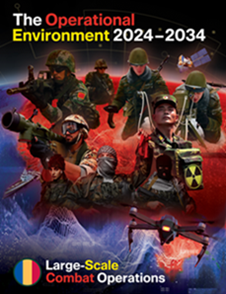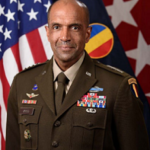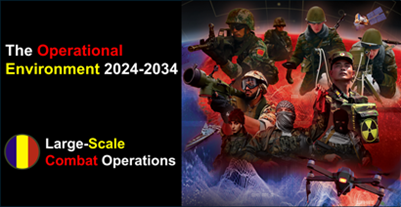[Editor’s Note: The mission of Army Mad Scientist is to explore the Operational Environment (OE) and the changing character of warfare on behalf of the U.S. Army. The OE underpins how the Army is organized, trained, equipped, and operates — it is foundational in ensuring the Army’s mission success — fighting and winning our Nation’s wars.
 The U.S. Army Training and Doctrine Command (TRADOC) Deputy Chief of Staff, Intelligence, G-2, has just published its new OE assessment. The Operational Environment 2024-2034: Large-Scale Combat Operations explores the twelve conditions likely to influence how the Army trains for and operates in Large-Scale Combat Operations (LSCO) during the period of 2024-2034. Given these LSCO conditions, TRADOC G-2 also identified five implications of modern LSCO that will likely affect how the Army adapts across its capabilities related to doctrine, organization, training, materiel, leadership and education, personnel, facilities, and policy (DOTMLPF-P).
The U.S. Army Training and Doctrine Command (TRADOC) Deputy Chief of Staff, Intelligence, G-2, has just published its new OE assessment. The Operational Environment 2024-2034: Large-Scale Combat Operations explores the twelve conditions likely to influence how the Army trains for and operates in Large-Scale Combat Operations (LSCO) during the period of 2024-2034. Given these LSCO conditions, TRADOC G-2 also identified five implications of modern LSCO that will likely affect how the Army adapts across its capabilities related to doctrine, organization, training, materiel, leadership and education, personnel, facilities, and policy (DOTMLPF-P).
In today’s post, we excerpt the Foreword by General Gary M. Brito, Commanding General, TRADOC, and the Executive Summary to provide our readers with a preview of this seminal document — check out the comprehensive assessment via the link at the bottom of this post. Enjoy!]
Foreword
The U.S. Army is facing new and increasingly perilous challenges compared to only a few years ago because of a rapidly modernizing pacing threat and an acute threat engaged in protracted large-scale combat operations on NATO’s doorstep. During two decades of counterinsurgency and counterterrorism, these traditional adversaries have watched as our Forces faced violent extremist organizations that had limited objectives and resources and used improvised weapons and tactics. Now, many of these threats have receded while our traditional adversaries with substantial defense budgets and global ambitions have reasserted themselves. They studied us as we executed operations and are using those lessons in their defense and strategic planning. To achieve victory in the Operational Environment of the 21st century, the U.S. Army must know these enemies like it knew the Soviets in the 20th century.
China, ![]() the pacing threat, is building defense systems to attain its global ambitions. It has the largest military in the world by personnel and the ability to execute a whole-of-nation approach to conflict that can quickly galvanize its industrial base. China’s modernization process has seen rapid technological transformation toward its vision of “informationized” and “intelligentized” warfare. It is also advancing an ambitious professional military education system with the aim of building a strong NCO corps.
the pacing threat, is building defense systems to attain its global ambitions. It has the largest military in the world by personnel and the ability to execute a whole-of-nation approach to conflict that can quickly galvanize its industrial base. China’s modernization process has seen rapid technological transformation toward its vision of “informationized” and “intelligentized” warfare. It is also advancing an ambitious professional military education system with the aim of building a strong NCO corps.
 Meanwhile, Russia, the acute threat, has been mired in an invasion of Ukraine since 2022. While not seeing the success it had hoped for initially, Russia is gaining combat experience in large-scale combat operations and proving that simply outlasting an enemy is a potentially valid military option. The war in Ukraine has shown that the next fight will prominently feature information warfare and focus on multidomain effects. Fires will be the center of gravity, making protection a priority and maneuver difficult.
Meanwhile, Russia, the acute threat, has been mired in an invasion of Ukraine since 2022. While not seeing the success it had hoped for initially, Russia is gaining combat experience in large-scale combat operations and proving that simply outlasting an enemy is a potentially valid military option. The war in Ukraine has shown that the next fight will prominently feature information warfare and focus on multidomain effects. Fires will be the center of gravity, making protection a priority and maneuver difficult.
 In its mission to describe the Operational Environment, the U.S. Army Training and Doctrine Command must distill all its observations and research into insights that the Army can apply. That is what this document endeavors to do, but it is only a first step. The information contained herein should be transmitted to, and understood by, U.S. Army Soldiers of every rank and at every echelon. Our Soldiers—our people—are our greatest strength and we must do everything we can to strengthen the profession of warfighting. Competence as an Army professional starts with understanding the threat, but it does not end there. Every Leader has the obligation of being a continuous and self-reflective learner outside of traditional professional military education and training.
In its mission to describe the Operational Environment, the U.S. Army Training and Doctrine Command must distill all its observations and research into insights that the Army can apply. That is what this document endeavors to do, but it is only a first step. The information contained herein should be transmitted to, and understood by, U.S. Army Soldiers of every rank and at every echelon. Our Soldiers—our people—are our greatest strength and we must do everything we can to strengthen the profession of warfighting. Competence as an Army professional starts with understanding the threat, but it does not end there. Every Leader has the obligation of being a continuous and self-reflective learner outside of traditional professional military education and training.

GARY M. BRITO
Commanding General, U.S. Army
Training and Doctrine Command
“To achieve victory, we must know the enemy. Knowing the enemy starts with the Operational Environment.”
Victory starts here!
Executive Summary
The U.S. Army Training and Doctrine Command (TRADOC) G-2, through its continuous observation and assessment of the Operational Environment (OE), identified 12 conditions that are likely to influence how the U.S. Army trains for and operates in large-scale combat operations (LSCO) during the period of 2024-2034. Given these LSCO conditions, TRADOC G-2 also identified five implications of modern LSCO that will likely affect how the U.S. Army adapts across its capabilities related to doctrine, organization, training, materiel, leadership and education, personnel, facilities, and policy (DOTMLPF-P). These implications are relevant, but not limited, to how the Army applies the OE to training and Leader development to establish the best conditions to succeed in LSCO. This document focuses on LSCO and does not cover the totality of Army operations in the OE over the next 10 years.
The key conditions that are likely to drive LSCO in the next 10 years include:
-
-
 LSCO will feature all-domain competition and warfare as competition and conflict extend beyond physical battles and increasingly involve multiple interconnected domains and dimensions.
LSCO will feature all-domain competition and warfare as competition and conflict extend beyond physical battles and increasingly involve multiple interconnected domains and dimensions.
-
-
-
 Mass and precision complement one another in LSCO, and combatants will need to identify the right mix of these factors to gain advantages.
Mass and precision complement one another in LSCO, and combatants will need to identify the right mix of these factors to gain advantages.
-
-
-
- The increase in the production,
 employment, and success of uncrewed systems means the Army can expect to encounter these systems across the breadth and depth of LSCO.
employment, and success of uncrewed systems means the Army can expect to encounter these systems across the breadth and depth of LSCO.
- The increase in the production,
-
-
-
 LSCO will require firing and sustaining massive amounts of munitions against adversaries likely to enjoy the initial advantage of interior lines, challenging the Army’s magazine depth and range.
LSCO will require firing and sustaining massive amounts of munitions against adversaries likely to enjoy the initial advantage of interior lines, challenging the Army’s magazine depth and range.
-
-
-
 LSCO will be marked by the democratization and proliferation of advanced technologies and hyperconnected global communications, creating an increasingly transparent battlefield that makes it difficult to hide from the enemy.
LSCO will be marked by the democratization and proliferation of advanced technologies and hyperconnected global communications, creating an increasingly transparent battlefield that makes it difficult to hide from the enemy.
-
-
-
 LSCO will be increasingly lethal due to the intersection of sensor ubiquity, battlefield automation, precision strike, and massed fires.
LSCO will be increasingly lethal due to the intersection of sensor ubiquity, battlefield automation, precision strike, and massed fires.
-
-
-
- In LSCO, U.S. Forces will face adversaries’
 anti-access/area denial (A2/AD) efforts focused on denying our deployment into theater and preventing our freedom of action once deployed.
anti-access/area denial (A2/AD) efforts focused on denying our deployment into theater and preventing our freedom of action once deployed.
- In LSCO, U.S. Forces will face adversaries’
-
-
-
 The increased logistics requirements of LSCO will challenge Army sustainment operations, and adversaries will target those same operations from the Homeland to the battlefield.
The increased logistics requirements of LSCO will challenge Army sustainment operations, and adversaries will target those same operations from the Homeland to the battlefield.
-
-
-
 LSCO will feature Homeland defense requirements as adversaries will have conventional, hybrid, and irregular capabilities to conduct operations against the Homeland.
LSCO will feature Homeland defense requirements as adversaries will have conventional, hybrid, and irregular capabilities to conduct operations against the Homeland.
-
-
-
 An increasingly urban OE means LSCO will include dense urban warfare in environments with challenging warfighting conditions.
An increasingly urban OE means LSCO will include dense urban warfare in environments with challenging warfighting conditions.
-
-
-
 The ability of adversaries to rapidly influence the information and human dimensions will challenge the Army’s ability to achieve information advantage in LSCO.
The ability of adversaries to rapidly influence the information and human dimensions will challenge the Army’s ability to achieve information advantage in LSCO.
-
-
-
 Adversaries view weapons of mass destruction (WMD) as an asymmetric advantage that has an outsized impact on U.S. operations and will likely seek to employ WMD in LSCO.
Adversaries view weapons of mass destruction (WMD) as an asymmetric advantage that has an outsized impact on U.S. operations and will likely seek to employ WMD in LSCO.
-
These LSCO conditions will have several likely implications for how the U.S. Army approaches a future LSCO conflict:
-
-
 LSCO is likely to require combatants to understand the dichotomy between the art and science of war to strike a balance that best exploits an adversary’s vulnerabilities and minimizes an adversary’s strengths.
LSCO is likely to require combatants to understand the dichotomy between the art and science of war to strike a balance that best exploits an adversary’s vulnerabilities and minimizes an adversary’s strengths.
-
-
-
 The human and materiel costs of LSCO suggest combatants will benefit from a clear understanding of how they view annihilation vs. attrition as a LSCO objective before hostilities commence.
The human and materiel costs of LSCO suggest combatants will benefit from a clear understanding of how they view annihilation vs. attrition as a LSCO objective before hostilities commence.
-
-
-
 Increased transparency, lethality, and challenges to movement in LSCO may require a reassessment of our approach to maneuver, fires, and protection.
Increased transparency, lethality, and challenges to movement in LSCO may require a reassessment of our approach to maneuver, fires, and protection.
-
-
-
 People are the advantage in LSCO, and the U.S. Army will need to maintain its overmatch in effectively recruiting, training, and developing world-class Soldiers and Leaders.
People are the advantage in LSCO, and the U.S. Army will need to maintain its overmatch in effectively recruiting, training, and developing world-class Soldiers and Leaders.
-
-
-
 The combatant in LSCO that makes rapid adaptation a fundamental part of its approach to warfighting will be better able to exploit fleeting opportunities on the battlefield.
The combatant in LSCO that makes rapid adaptation a fundamental part of its approach to warfighting will be better able to exploit fleeting opportunities on the battlefield.
-
These conditions and implications illustrate the complexity of LSCO in a dynamic OE. They provide the U.S. Army with much to consider as it adapts its doctrine, trains its Soldiers, and develops its Leaders to execute LSCO in support of national security objectives.
If you enjoyed this brief excerpt, check out the complete assessment at The Operational Environment 2024-2034: Large-Scale Combat Operations.
Explore the TRADOC G-2‘s Operational Environment Enterprise web page, brimming with information on the OE and how our adversaries fight, including:
Our China Landing Zone, full of information regarding our pacing challenge, including ATP 7-100.3, Chinese Tactics, BiteSize China weekly topics, People’s Liberation Army Ground Forces Quick Reference Guide, and our thirty-plus snapshots captured to date addressing what China is learning about the Operational Environment from Russia’s war against Ukraine (note that a DoD Common Access Card [CAC] is required to access this last link).
Our Russia Landing Zone, including the BiteSize Russia weekly topics. If you have a CAC, you’ll be especially interested in reviewing our weekly RUS-UKR Conflict Running Estimates and associated Narratives, capturing what we learned about the contemporary Russian way of war in Ukraine over the past two years and the ramifications for U.S. Army modernization across DOTMLPF-P.
Our Running Estimates SharePoint site (also requires a CAC to access), containing our monthly OE Running Estimates, associated Narratives, and the 2QFY24 and 3QFY24 OE Assessment TRADOC Intelligence Posts (TIPs).
Check out the following related Mad Scientist Laboratory blog posts:
Know Your Enemy: Army Doctrine Starts with the Threat and associated podcast, with General Gary M. Brito, Colonel Rich Creed (USA-Ret.), and Mr. Ian Sullivan
China’s PLA Modernization through the DOTMLPF-P Lens, by Dr. Jacob Barton
Insights from Ukraine on the Operational Environment and the Changing Character of Warfare
Unmanned Capabilities in Today’s Battlespace
Revolutionizing 21st Century Warfighting: UAVs and C-UAS
War Laid Bare, by Matthew Ader
The Operational Environment’s Increased Lethality
The Hard Part of Fighting a War: Contested Logistics
Future Dynamics of Warfare: Everyone is a Player, Everything is a Target, by Team Sullivan’s Travels
Dense Urban Environments (DUE): Now through 2050
China and Russia: Achieving Decision Dominance and Information Advantage by Ian Sullivan
WMD Threat: Now and in the Future
Innovation at the Edge and associated podcast



